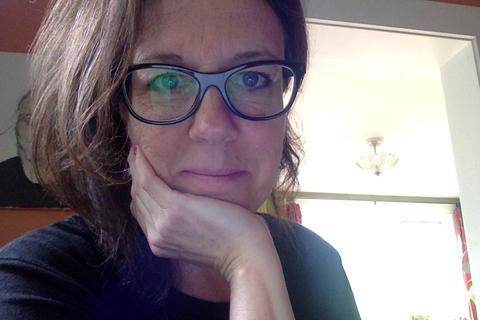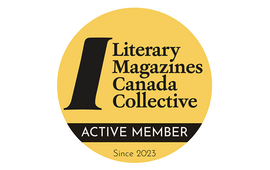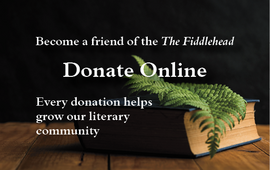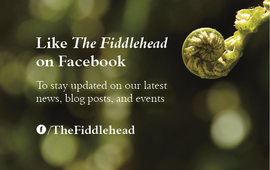
Editorial Assistant Douglas Walbourne-Gough interviewed Sue Goyette about emergence, vulnerability, and engagement in the practices of writing and reading poetry. An excerpt from Sue Goyette's book-length poem, Anthesis, will appear in the upcoming special 75th anniversary issue of The Fiddlehead that will be published in spring.
Douglas Walbourne-Gough: Along the theme of looking forward, the title of the piece from which your excerpt comes is Anthesis – the flowering period of a plant. Are there any projects of your own that are emerging soon, or that you’re planning on, that you’d like to speak to?
Sue Goyette: The excerpt is part of a book-length poem that is a reclamation of the autobiographical aspect of myself as a girl portrayed/characterized in my novel, Lures. This reclamation was the outcome of the reckoning I was doing in therapy that was addressing the issues that arise when constructing fiction from biography. I was concerned with how I wrote that character to align with the story, the narrative, and, in this way, how I abandoned myself as a girl. Does that make sense? I align this thinking/creating with a lateral temporality, a fluid sense of time and am going backward in order to move forward intact and in better service to myself. This feels like a necessary part of healing, this looking back to move forward, whether it’s for decolonizing or ecological purposes. The wider view of the approach acknowledges past harms and begins the restorative process, first with grief, accountability, and then with repair. This engagement instigates a vulnerability that I am still getting used to.
DWG: I can’t help but think of summer 2018 when you were sharing daily progress of an agave’s anticipated anthesis. Instead of analogies of a poet, a book, or a poem’s flowering, would you be willing to speak to the process, the experience, and the reward of that time and energy spent with the agave? Unless the agave is something you’ve been asked about too much recently—I simply adored the daily posts and finally have the chance to ask you about them. We can skip this question entirely, though, if it’s too on-the-nose with your excerpt.
SG: Developing a relationship with the agave plant was a master class in an emergent and manifesting of radical vulnerability, something, as I mentioned, I’ve been choosing to engage with. I had just finished a year of graduate course work in a women and gender studies program and was feeling so bleak, so consumed by the various systems of oppression and how they sustain each other and how I inadvertently perform oppression on myself, on others, that I could barely move. This macro learning had settled into my personal/micro understanding and the agave, when it appeared far too early because it had outgrown the greenhouse, broke through the malaise I had fallen into. I immediately became alert to its dilemma because it felt similar to mine. In a way, it was making legible the research I was doing for my thesis, which involved personal and community trauma and the opportunities that present themselves in the form of crisis or chaos. And so I started visiting the plant every day, photographing its progress, and it immediately became the most vital part of my days.
People started responding to the photos I shared daily on social media. I had many conversations online and in person about how meaningful an experience it was watching this plant bloom, considering it is monocarpic, meaning it will only bloom one time and then will die. Is it strange to say I felt a deep kinship to this? To say I could relate to this effort? I had begun to see a therapist to work out some of my own trauma and the work and understanding I learned in those sessions also aligned with the agave and how it was manifesting. Ultimately, I understood that I was engaging with the agave’s progress the way I engage in the constructing of a poem. This felt meaningful, so I stepped back and let it show me what it was becoming. This attending, participating relationally in this way by actively watching and committing to that watching for the long haul, felt like the opposite of oppression. So, in its way, the experience of the agave greened me back to my vitality and I’m still profoundly grateful for its company.
DWG: I’m really taken by the phrase “We all scream for the right window.” Looking forward in 2020, to 2030, to 2040, and all these so seemingly sci-fi dates complete with all their hopeful, dystopian, terrible, and beautiful possibilities, what, if anything, do you want to scream or see screamed (or, alternatively, sung) at the right window? What does that window look like for you?
SG: Out of context of the poem, the question widens and the first answer that comes to mind is green. Meaning seeing growing things in regards to forward looking into a future. Green and vital. The second thing that comes to me is how my idea of the right window not only opens but opens wide enough for departure and for entry. So that window is a portal out into a wilder home and back into a more private one: a smaller escape hatch than a door and a more private invitation for entry. And if windows are physical manifestations of another species of, say, a hyperlink, then this window, the right window, is situated in good company of other windows, a community of windows that are compact portals into a diversity of people living good, interesting, and engaged lives that I can sometimes hear or smell or see or be part of. And I want it positioned to get as much sun, as much moonlight as it can. With curtains.
DWG: The last lines of the excerpt ask “[d]o you want something beautiful and wild, extensively alone? A / poem about navigating the opposite direction from a lighthouse?” Do you? If so, what allows you to row directly away from the lighthouse, to be “wild[ly], extensively alone”? What brings you back?
SG: Yes, I willingly grapple with wildness and its emergence in my writing practice. I think what affords me the experience of leaving shore and its sense of safety is the continual practice of transforming my fear and any sense of expectation or outcome into curiosity. This practice is ongoing and invigorating. I sometimes fall short at it. It involves risk. And sure, it’s a risk that I take at my desk, on paper, but it realigns me and keeps me supple and ready for the occasions I find myself having to embark, to participate in an unplanned thing that has deeper waters and a harder current that I have no choice to go along with. Life’s wildness, I guess, and all its curves. One of these is the climate crisis and the state of our planet and the state of the state. I want to be able to think without a lighthouse, to risk, to see a way forward or out of. A way that embarks and connects back, not to the lighthouse, but to the land.
Reading that line/question now, I’m also struck by how it’s an invitation to a reader as well, to engage thusly. Not knowing how but engaging nonetheless. It’s invigorating to think about this level of engagement, how poetry is enlivened by its reader and their willingness to participate, which creates a circuitry for that vulnerability I mentioned earlier and the different ways we can practice it with each other and, more widely, with all of the creatures and rivers and trees. Again, no small thing and not an easy thing to do.
What brings me back? A lofty answer is the thought of embarking again, the return in order to start again. The answer more rooted in day-to-day reality is a schedule, responsibilities, the need to fortify my spirit and my body, my beloveds, the appetite for music, to watch some dance. Art. Netflix. Mostly, I’m disrupted by having to make a living, so money.
Sue Goyette lives in K'jipuktuk (Halifax), the unceded and unsurrendered land of the Mi’kmaq peoples. She has published six books of poems and a novel. Her latest collection is Penelope (Gaspereau Press, 2017). Sue teaches in the Creative Writing Program at Dalhousie University.











Comments
Sue Goyette
Add new comment